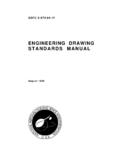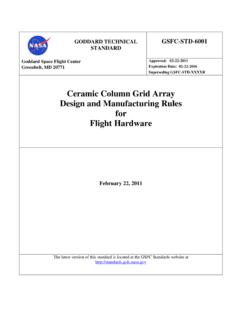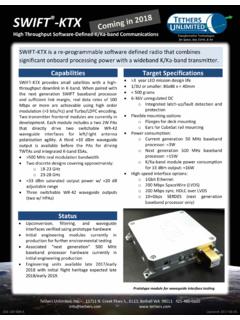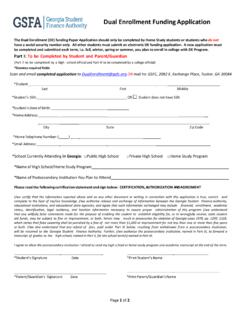Transcription of FLIGHT ASSURANCE PROCEDURE Page 1 of 10
1 FLIGHT ASSURANCE PROCEDURE Page 1 of 10. SUBJECT: PERFORMING A FAILURE MODE AND NUMBER: P-302-720. EFFECTS ANALYSIS REV. : Original PURPOSE. This PROCEDURE establishes guidelines for conducting a Failure Modes and Effects Analysis (FMEA) on GSFC spacecraft and instruments. REFERENCE. a. NHB Reliability Program Requirements for Aeronautical and Space System Contractors b. CR Payload and Experiment Failure Model and Effects Analysis and Critical Items List Groundrules c. MIL-STD 1629 procedures for Performing a Failure Modes, Effects, and Criticality Analysis DEFINITIONS. a. Failure Mode - A particular way in which an item fails, independent of the reason for failure. b. Failure Mode and Effects Analysis (FMEA) - A PROCEDURE by which each credible failure mode of each item from a low indenture level to the highest is analyzed to determine the effects on the system and to classify each potential failure mode in accordance with the severity of its effect.
2 C. Indenture Levels - The hierarchy of hardware levels from the part to the component to the subsystem to the system, etc. d. Redundancy - More than one independent means of performing a function. There are different kinds of redundancy, including: (1) Operational - Redundant items, all of which are energized during the operating cycle; includes load-sharing, wherein redundant items are connected in a manner such that upon failure of one item, the other will continue to perform the function. It is not necessary to switch out the failed item or switch in the redundant one. FLIGHT ASSURANCE PROCEDURE Page 2 of 10. SUBJECT: PERFORMING A FAILURE MODE AND NUMBER: P-302-720. EFFECTS ANALYSIS REV. : Original DEFINITIONS (cont.). (2) Standby - Items that are inoperative (have no power applied) until they are switched in upon failure of the primary item.
3 (3) Like Redundancy - Identical items performing the same function. (4) Unlike Redundancy - Nonidentical items performing the same function. SCOPE. Typical ground rules for an FMEA are given along with an overview of the technique, principal, step-by-step instructions, sample work sheets, and work sheet data entries. Specific projects must, of course, add to, delete and otherwise tailor the procedures to conform with their needs, objectives, and contractual requirements. That is particularly true of safety issues or workaround operational methods. Although software analysis is outside the scope of an FMEA, the effects of failure modes at both software and hardware-software interfaces are included. INSTRUCTIONS. GENERAL. Objective of the FMEA. The objective of an FMEA is to identify the way failures could occur (failure modes) and the consequences of the failures on spacecraft performance (failure effect) and the consequences on mission objectives (severity assignment).
4 It is based on the usual case on which failure effects, which are expressed at the system level, are caused by failure modes at lower hardware levels. The PROCEDURE herein, does not quantify the probability for failure occurrence; rather a qualitative assessment of the failure effect is gained by assigning the failure mode to a severity category. FLIGHT ASSURANCE PROCEDURE Page 3 of 10. SUBJECT: PERFORMING A FAILURE MODE AND NUMBER: P-302-720. EFFEC TS ANALYSIS REV. : Original INSTRUCTIONS (cont.). The results of the analysis are used to improve system performance by initiating corrective action, usually design changes; they are also useful in focusing product ASSURANCE procedures and identifying operational constraints. The FMEA is updated as necessary to include design changes and operational revisions.
5 Methodology A bottom-up methodology, the FMEA is initiated by selecting the hardware at the lowest level of interest ( , component module, circuit, part). The various failure modes that can occur for each item at that level are tabulated. The corresponding failure effect, in turn, is interpreted as a failure mode at the next higher functional level. Successive iterations result ultimately in identification of the failure effects up to the highest system level. It is a process of inductive synthesis. Timing The effectiveness of the FMEA in the design process is dependent upon its early use in the identification of problems and the communication of the information gained to project personnel who can initiate changes before design becomes fixed. Therefore, the FMEA should be initiated as soon as preliminary design information is avai lable and then applied at greater depth as the design takes shape.
6 Preliminary Subsystem Analysis During the conceptual phase of system development, when design information is limited to block diagrams, a functional approach is appropriate for identifying design problems. Failures are postulated for the major subsystems (the subsystems can also be broken down into lower-level blocks). The effects are assessed, and conceptual design changes are made as necessary. The identified failures are assigned to a severity category (defined in ) with emphasis given to catastrophic and critical failures for which possible workaround procedures can be planned. Detailed Hardware Analysis Detailed hardware analysis is conducted when hardware items, signal lines, and power lines have been assigned. Using schematics and assembly drawings, failure modes are FLIGHT ASSURANCE PROCEDURE Page 4 of 10.
7 SUBJECT: PERFORMING A FAILURE MODE AND NUMBER: P-302-720. EFFECTS ANALYSIS REV. : Original INSTRUCTIONS (cont.). postulated and their effects assessed. The failure modes are defined at the component interface, based on knowledge of the internal design and the effects are assessed at the component level are upward to higher hardware levels of assembly. The hardware level at which analysis begins is included in the project's Statement of Work, which usually requires analysis to the component level. The analysis is often extended to the part level as needed; that is especially true for safety considerations. At the part level, failure modes are defined for the parts within a component and the effect is assessed at the component interface. Failure Modes All the ways that a failure may occur at the har dware indenture level are identified.
8 All probable, possible, or credible modes of failure are postulated; they include failure mechanisms that have been observed historically and whose mechanisms have been described in accordance with sound engineering reasoning. The identification of the failure modes is based on a knowledge of the component, functional specifications, interface requirements, schematics, or failure modes of the piece parts associated with the interface. Failure modes at interfaces typically involve electrical connectors. Failures within the unit appear as short to ground, short to a voltage or open, for both signal and power lines. The analysis is for the purpose of detecting potential interface failures o riginating within the unit; the failure modes internal to the connectors are not considered. Although it is not necessary to understand circuitry adjacent to connectors in order to identify a generic set of failure modes, such an understanding will help rule out certain failure modes and thereby reduce the amount of analytical work that has to be done.
9 Failure modes that occur within a unit, be it electrical or mechanical, are manifested at the interface by one of the following failure conditions: a. Premature operation, b. Failure to operate at a prescribed time, FLIGHT ASSURANCE PROCEDURE Page 5 of 10. SUBJECT: PERFORMING A FAILURE MODE AND NUMBER: P-302-720. EFFECTS ANALYSIS REV. : Original INSTRUCTIONS (cont.). c. Failure to cease operation when required. d. Failure during operation. The Hardware-Software Interface Although software analysis is outside the scope of an FMEA, the hardware-software interfaces are examined from two perspectives: a. Failures of the hardware that result in improper or lack of response to the software. b. Failures in the software that affect hardware operations. The results are brought to the attention of software designers and analysts for their consideration and possible corrective action.
10 Examples of failures in the software that affect hardware operation follow: a. Commands are too early. b. Commands are too late. c. Failure to command. d. Commands erroneously. Failure Effect Severity Categories To provide a qualitative measure of the failure effect, each failure mode is assigned to a severity category. Safety issues and impact to other systems or property are reflected in the selection of the severity category. The failure effect is assessed first at the hardware level being analyzed, then the next higher level, the subsystem level, and so on to the system or mission level. In selecting the severity category, the worst case consequence, considering all levels, are assumed for the failure mode and effect being analyzed. Severity categories are defined below. Specific projects may require expanded definitions depending, for example, on the amount of degradation that is allowable in the return of scientific data.







